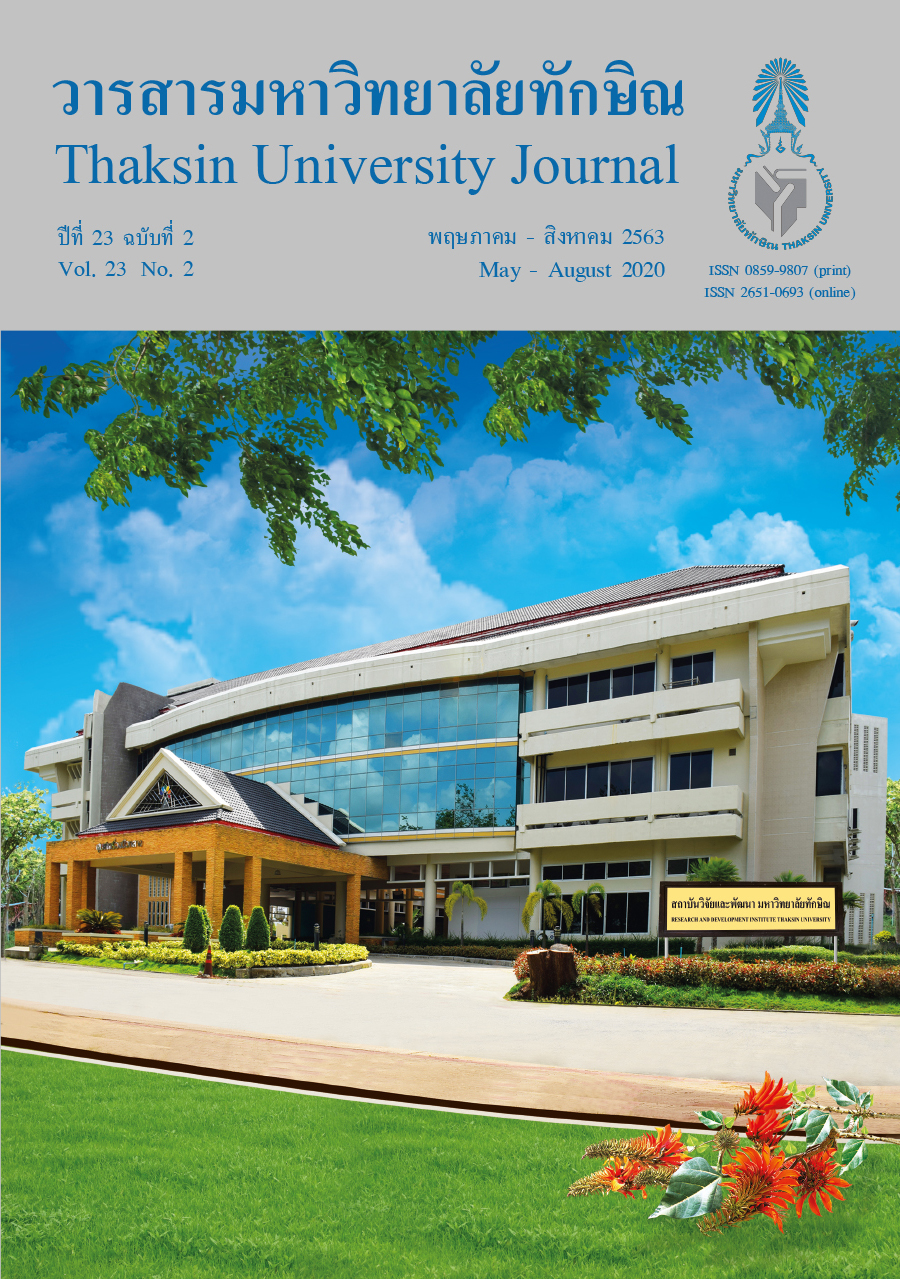Production of Biodegradable Plastics from Sago Fibers
Main Article Content
Abstract
Nowadays, polymeric materials have been widely used due to their advantage properties such as lightweight, high strength, and chemical resistance. However, the polymers cause environmental pollution problem because most of them are non-biodegradable. Therefore, this research purposed to investigate the production and properties of biodegradable plastic produced from sago fibers using the commercial
cassava starch as a binder. The biodegradable plastic was produced by hot compression process at temperature of 150 °C with 500 psi pressure and holding for 15 min. The ratios between sago fibers and the binder were 1:1, 6:4, 7:3, 8:2, 9:1, and 1:0 by weight. The mechanical and physical properties of all samples were characterized. The results indicated that the fiber content increase, density and tensile strength decreased. The sago fibers to binder at the ratio of 1:1 by weight showed the optimum tensile strength of 4.24 ± 0.92 MPa. In contrast, water absorption of the fibers increased due to the fiber created the voids in the samples, while the hardness of all samples were similar. In addition, the samples were in landfills for 28 days in order to biodegradability test. The sample prepared form sago fibers to binder ratio of 1:0 by weight exhibited the highest degradability. From the study, it can be concluded that sago fibers can be prepared as biodegradable plastic for the future application.
Article Details

This work is licensed under a Creative Commons Attribution-NonCommercial-NoDerivatives 4.0 International License.
References
Silva-Guzmán, J. A., Anda, R. R., Fuentes-Talavera, F. J., Manríquez-González, R., & Lomelí-Ramírez, M. G. (2018). Properties of thermoplastic corn starch based green composites reinforced with barley (Hordeum vulgare L.) straw particles obtained by thermal compression. Fibers and Polymers, 19(9), 1970–1979.
Prachayawarakorn, J., Chaiwatyothin, S., Mueangta, S., & Hanchana, A. (2013). Effect of jute and kapok fibers on properties of thermoplastic cassava starch composites. Materials and Design, 47, 309–315.
Corradini, E., de Carvalho, A. J. F., da Silva Curvelo, A. A., Agnelli, J. A. M., Mattoso, L. H. C. (2007). Preparation and characterization of thermoplastic starch/zein blends. Materials Research, 10(3), 227–231.
Jaafar, J., Siregar, J. P., Oumer, A. N., Hamdan, M. H. M., Tezara, C., & Salit, M. S. (2018).Experimental investigation on performance of short pineapple leaf fiber reinforced tapioca biopolymer composites. BioResources, 13(3), 6341–6355.
Lu, D. R., Xiao, C. M., & Xu, S. J. (2009). Starch-based completely biodegradable polymer materials. eXPRESS Polymer Letters, 3(6), 366–375. DOI:10.3144/expresspolymlett.2009. 46.
Kaushik, A., Singh, M., & Verma, G. (2010). Green nanocomposites based on thermoplastic starch and steam exploded cellulose nanofibrils from wheat straw. Carbohydrate Polymers, 82(2), 337–345.
Guimarães, J.L., Wypych, F., Saul, C.K., Ramos, L.P., & Satyanarayana, K.G. (2010). Studies of the processing and characterization of corn starch and its composites with banana and sugarcane fibers from Brazil. Carbohydrate Polymers, 80(1), 130–138.
Flach, M. (1997). Sago Palm: (Metroxylon Sagu Rottb.). Rome: International Plant Genetic Resources Institute (IPGRI).
Markphan, W., Chankaew, S., & Tiprug, U. (2016). An economic evaluation of the direct use of Sago Palm in Phatthalung province and Trang province. Thaksin University Journal, 19(2), 99–108.
Lui, F., Chiou, B. -S., Avena-Butsillos, R. J., Zhang, Y., Li, Y., McHugh, T. H., & Zhong, F. (2017). Study of combined effects of glycerol and transglutaminase on properties of gelatin films. Food Hydrocolloids, 65, 1–9.
Riyajan, S.A. (2015). Robust and biodegradable polymer of cassava starch and modified natural rubber. Carbohydrate Polymers, 134, 267–277.
Lomeli-Ramírez, M. G., Kestur, S. G., Manriquez-González., R., Iwakiri, S., de Muniz, G. B. d., & Flores-Sahagun, T. S. (2014). Bio-composites of cassava starch-green coconut fiber: Part IIstructure and properties. Carbohydrate Polymers, 102, 576–583.
Schmidt, V. C. R., & Laurindo, J. B. (2010). Characterization of foams obtained from cassava starch, cellulose fibres and dolomitic limestone by a thermopressing process, Brazilian Archives of Biology and Technology, 53(1), 185–192.
Sanhawong, W., Banhalee, P., Boonsang, S., & Kaewpirom, S. (2017). Effect of concentrated natural rubber latex on the properties and degradation behavior of cotton-fiber-reinforced cassava starch biofoam. Industrial Crops and Products, 108, 756–766.
Riyajan, S., & Patisat, S. (2018). A novel packaging film from cassava starch and natural rubber. Journal of Polymers and the Environment, 26(7), 2845–2854.


